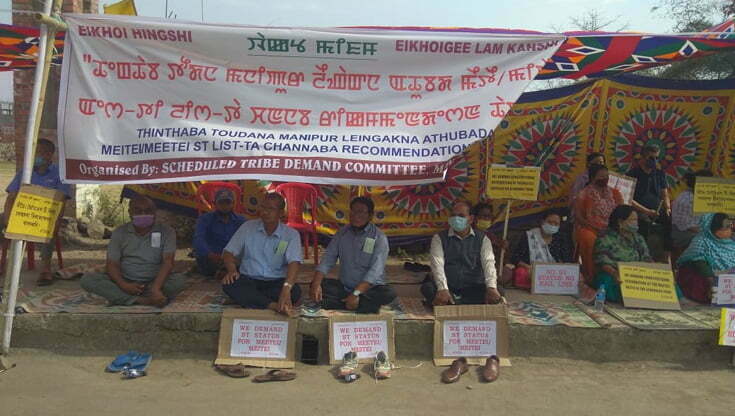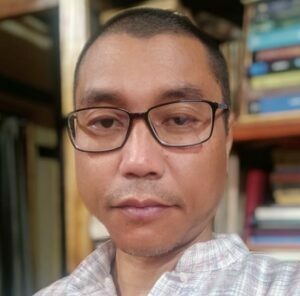
India’s reservation policy has spawned forms of conflicting categories of the ‘exploiter’ and the ‘exploited’, the ‘dominant’ and the ‘subservient’ as if these binaries exist in a permanent cycle sans the dynamics of wresting political power at play.

By Dhiren A. Sadokpam
In recent times, the political elites of three primary ethnic groups in Manipur are caught in a whirlpool of anxiety propelled by palpable dissonance in political objectives. This anxiety is not necessarily triggered by the differences in speculative autonomy-demands or even demands based on administrative separatism.
The main anxiety has been caused by the way how the communities have effectively understood the political ideas behind positive discrimination, affirmative action or what in the Indian subcontinent is being referred to as the reservation policy of communities that have apparently lagged behind in holistic development. The most recent play-out that has triggered the spells of anxiety and tension has been the demand of a community considered advanced in comparison to its neighbours, to be included in the Scheduled List of Tribes in India.
While the proponents of the demand and those opposing the same have resorted to socio-political and historical reasoning, both the parties seem to have skipped re-looking at either redefining or refining the concepts they would love to toy with. One is not sure if both the conflicting parties have understood that India’s reservation policy presupposes a social fact – centuries of oppression of one group by another. This presupposition assumes a determinate but constant ‘unchanging oppressor and oppressed’ and ‘advanced’ and ‘backward’ communities. The ‘constant’ is supposedly created by a social order that determined identities of each castes, communities and tribes. This has spawned forms of conflicting categories of the ‘exploiter’ and the ‘exploited’, the ‘dominant’ and the ‘subservient’ as if these binaries exist in a permanent cycle in all societies sans the dynamics of wresting political power at play.
For the mainland India, these terms are defined in relation to the hereditary caste order whereas for Northeast India, the same has been defined by amorphous understandings of communities guided by colonial agenda of the British whose administrators first chose to categorize people from the mixed-prism of the caste order or an anthropological understanding of a system which they considered was durable.
It is against this backdrop that United Naga Council, Manipur (UNC) and the Kuki Inpi Manipur (KIM) have raised objections to the Manipur High Court’s directive to the Government of Manipur to send its recommendation for the inclusion of Meetei Community in the list of Scheduled list of Tribes to the Government of India. The directive of the high court was passed on March 27.
Strident Voices and Social Tension
The UNC stated that “the Meitei/Meetei community of Manipur is an advanced community of India” with their language, Manipuri (Meiteilon) listed in the Eight Schedule to the constitution of India.
“They are already protected under Constitution of India and categorized as (i) General (ii) Other Backward Classes (OBC) and (iii) Schedule Caste (SC),” said the UNC.
UNC termed it irrational that the High Court of Manipur directed the Government of Manipur to recommend for inclusion of Meitei/Meetei community in the Scheduled Tribe (ST) list of India, “negating the sole objective of scheduling group of people for protective discrimination as ST in the Constitution of India”. The Naga body has strongly condemned and called the high court order “inane” for making “such imbecilic recommendation despite strong opposition from Scheduled tribes of the state”.
The common refrain and rationale behind the objections raised by both UNC and KIM has been rubbished by the proponents of those demanding a Scheduled Tribe status for the Meetei community. One strident voice has been that of the Kangleipak Kanba Lup (KKL). KKL has critiqued the objections in their own characteristic way stating that the demand for the inclusion of Meetei in the Scheduled list of Tribes in the Constitution of India is not aimed at grabbing “jobs” either from the Naga or Kuki communities of Manipur. It has asserted that the demand is based on safeguarding their “little bit of land” now confined to less than 2000 square kilometers out of the 20,000 square kilometers of the entire state of Manipur.
The KKL has made it clear that the Naga and the Kuki communities need not fear about grabbing “their job reservation quotas currently enforced in Manipur which will remain status quo”. The organization also unequivocally asserted that the UNC and KIM have “no birth right” to deny any other scheduled tribes of India that job opportunity.
The KKL had a message for the UNC too. It reiterated that the Manipuri Language being classified as scheduled languages of India under the Eight Schedule has nothing to do with the classification of the Meetei as a scheduled tribe of India. “Anyway Manipuri language is not confined to the Meeteis only but serves as a Lingua Franca amongst all the tribal communities of Manipur be it between the Nagas and the Kukis but amongst their various sub-tribes also”, it pointed out.
Moreover, the UNC has also been reminded that it was Th Muivah, the top National Socialist Council of Nagalim (NSCN-IM) leader who had stated that “only the Nagas and the Meeteis are the indigenous peoples” of Manipur. KKL asked, “So what is the idea of joining hands with the Kukis to block the way for the survival of the Meeteis under the Indian Constitution”. To the question of Meeteis being more advanced than the other tribes of Manipur, KKL asserted that it has nothing to do with genealogy but “mode of production” experienced by the communities.
The Meetei community began to practice settled agriculture and had more time to concentrate on arts, culture and literature while the hill tribes hitherto used to follow a different form of agriculture “before switching to poppy plantation” in recent times that had made them “all become rich”, said KKL.
The organization winded up their statement on a harsher note stating that it would be wrong on the part of both the Naga and the Kuki communities to consider the Meetei community as their “common enemy or else will be constrained to oppose every move or demand made by any tribal group either Naga or Kuki”.
The exchange of statements may not lead towards a reconciliation on the sensitive topic. As the articulation of the issue by those supporting the demand for inclusion of Meetei in Scheduled Tribe list up the ante on their movement, the objections by Naga and Kuki tribal bodies may get shriller by the day.
Empowerment and Social Justice
In all these voices, what has been missed is a dispassionate inter-community/ethnic group deliberation on what would be the best option for all communities to progress and under what protective or empowering mechanism. While the fact of discrimination cannot be denied in one’s everyday experience, ethnicization or communalization of the issue would only create unbridgeable distance between communities. Under such circumstances, one will not be able to project the fact that there are no permanent oppressor and permanent oppressed or instil the fact that the idea of permanent and constant binaries will lead to over-generalization of a theoretical framework to achieve quick practical results.
What is of utmost importance now is truly and honestly grasping the fact that emancipating the socially underprivileged and the marginalized irrespective of community or tribal affiliation or within the same community is a move towards social justice. While doing so, one should not forget that the idea of empowerment of the individual has a far greater value and virtue than a protective mechanism that tends to perpetuate redundant binaries or historical contradictions.
Here, it should also be noted that India’s reservation policy emerged out of a deep flaw in understanding the complex relationship between the conceptions of the ‘cultural/social’ and the ‘economic’. Having said this, elsewhere, this writer had also argued that the stereotyping of the Meetei as a Hindu society both within Manipur and outside, in the image of mainland Hindu ethos and practices has manufactured the idea of the ‘constant exploiter’ and the ‘constant exploited’ in Manipur.
While Hinduised Meeteis have been identified with the former, all other non-Hindu communities are shown as ‘exploited’. Such is the handiwork of those who harp on the ‘politics of divide’ and benefit from it; and endorsed by the ‘ignorant other’ who is happy to own up anything that comes closer to the intolerant and imagined pan-Indian vision.
(Dhiren A. Sadokpam is Editor-in-Chief, The Frontier Manipur. This article was first published by EastMojo under the title ‘ST demand for Meetei: First, acknowledge the cracks within’)
The post ST Demand Issue: Positive discrimination, affirmative action and the cracks within first appeared on The Frontier Manipur.
Read more / Original news source: https://thefrontiermanipur.com/st-demand-issue-positive-discrimination-affirmative-action-and-the-cracks-within/







